Left Bank: Hidden Treasures of Paris in Plain Sight, Part 3
- SUBSCRIBE
- ALREADY SUBSCRIBED?
BECOME A BONJOUR PARIS MEMBER
Gain full access to our collection of over 5,000 articles and bring the City of Light into your life. Just 60 USD per year.
Find out why you should become a member here.
Sign in
Fill in your credentials below.
Ahhhh the rive gauche, the home of the Latin Quarter, Jardin du Luxembourg and the Eiffel Tower. The ancient, cobbled streets that were well traveled by the Lost Generation of Hemingway and Fitzgerald and the great artists and authors of the 20th century. It was any given day you would see Picasso, Dora Maar, Jean Paul Sartre or Simone de Beauvoir on the terrace of Les Deux Magots enjoying their morning coffee or an early evening apéro. You could wander for hours in Saint-Germain-des-Prés, stopping at every plaque along the way learning about the people that called the Left Bank home. Tourists are numerous in the area, but many may never slow down enough to notice some of the treasures that are hidden in plain sight.
Few details are overlooked in Paris; it is one of the amazing things that the planners going back hundreds of years took into account. From the grates that surround the base of a tree to the green benches in the parks, no detail is too small– but frequently missed by passersby.

Jardin des Plantes. Photo: Paris Tourist Office/ Amelie Dupont
The Jardin des Plantes is a beautiful oasis off the banks of the Seine in the 5th arrondissement that includes a zoo and numerous museums. The lush landscape is filled with a peony garden, alpine garden, iris garden and– in the center leading up to the Grand Galerie de l’Évolution– a vast garden that is filled with pink blossoms in the spring. As you walk around, look down and you may find a little piece of Notre-Dame cathedral. All over the Jardin des Plantes the small, round grates that catch the rain aren’t the standard design. Look closely; they are in the shape of the rose windows of the Notre Dame de Paris. Created by the Jacquemin Fonderie, these lovely iron grates are exactly what make Paris so magical. I have spotted them around Paris a few other times– inside inner courtyards behind locked doors– so keep your eyes out for these little beauties.
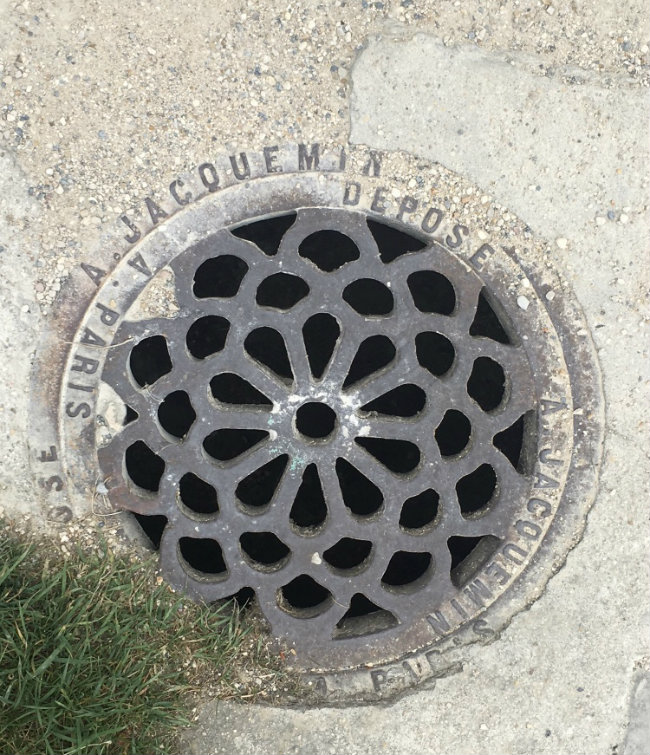
A grate in the shape of Notre Dame’s rose windows. Photo: Claudine Hemingway
A short and lovely walk from the Jardin des Plantes is the Rue Mouffetard, one of the best streets in Paris, leading to the Place de la Contrescarpe that Hemingway mentioned in A Moveable Feast and just around the corner from his first apartment. Continue down Rue Descartes and a left on Rue Clovis. The street named for the king of the Franks holds one of the best remnants of the wall of Philippe Auguste. In the past Hidden Treasure articles, we have seen the wall in a parking garage and a basketball court. Of the many visible remains in Paris, this one on Rue Clovis gives you an idea at just how wide the wall was.
A few steps away the Église Saint-Étienne-de Mont rises up in the shadow of the Pantheon. The church is well known for what is outside of it, but don’t skip going inside this gem. The steps on the north side are always filled with fans of the Woody Allen film Midnight in Paris, looking to recreate their own Gil moment to travel back in time. Head inside the church for a real treat. In front of you at the altar is the last Jube screen in Paris. Created by artist Biart le père, the single span screen stretches above the choir and on either side are carved stone stairs that are stunning. Biart carved angels, mascarons, ivy and palm trees into the screen that was once used during sermons. The Jube screens were commonly seen in many of the churches of Paris before removed. Notre Dame de Paris had one as well before they were abolished by the Council of Trent to bring the congregation closer to the choir. Take some time to walk around Saint-Étienne, the relics of Sainte Geneviève, the patron saint of Paris that saved it from the attack of Attila the Hun, are in a side chapel with beautiful stained glass windows telling the story of the life of Geneviève.
Head down Rue Soufflot and take a right onto Rue Saint-Jacques. The Rue Saint-Jacques was once the cardo of Roman Lutetia, long before Paris became Paris. The north-south road led to the Chemin de St-Jacques and the Santiago de Compostela. At 27 Rue Saint-Jacques look up at the corner; one of the 120 sundials that can be found around Paris resides on the corner. This isn’t your normal sundial, it is by artist Salvador Dali. Placed on 15 November 1966, Dali had created it for a friend that owned the shop beneath it. The sundial is a woman’s face on a scallop shell, a nod to the Saint-Jacques de Compostelle. Her blue eyes shine beneath her eyebrows set aflame like the sun. Her hair cascades down forming the recognizable mustache of her creator. Dali’s signature can be seen in the lower right hand corner, but don’t set your watch to it, the surrealist artist never designed it to work.
The Jardin du Luxembourg is filled with over 100 statues that line the terrace, hide beneath the tree-lined paths, and sit majestically in the middle of the perfectly trimmed grass. On the eastern side of the park a few steps from the terrace with the statues of the Queens of France, down a path is the statue with the faces of the great artists. Le Marchand de Masques by Zacharie Astruc is a statue of a young boy selling masks. In his hand, he holds the mask of the French novelist, Victor Hugo. At his feet are the faces of eight of the greatest French artists, authors and musicians. You can come face to face with landscape artist Jean-Baptiste-Camille Corot, novelist Alexandre Dumas, composer Hector Berlioz, sculptor Jean-Baptiste Carpeaux, operatic baritone Jean-Baptiste Faure, novelist Honoré de Balzac, novelist Jules Barbey d’Aurevilly and, a personal favorite, Eugène Delacroix. The entire Jardin du Luxembourg is worth an entire day exploring, sitting in the sun reading, and do not forget a picnic to set up on one of the iconic Luxembourg green chairs.

Le Marchand de Masques. Photo: Claudine Hemingway
Walking along the Rue Saint-Sulpice on your right is the largest church on the left bank– only a tad bit smaller than Notre Dame de Paris. While you walk in the shadows of the church look to the left to find a remnant of a seedier time in Paris. At no. 36 Rue Saint-Sulpice, above the door is the address, but just a bit fancier than any other numbers on the street. Why such a lovely number on what appears to be a regular Paris façade? During the Belle Epoque, Paris was celebrating the good life and that even went for a man looking for, how shall we say, companionship. The fancy and normally larger numbers signified this address was a maison close, a really French way of saying brothel. Miss Betty ran this brothel in the very narrow six-floor building that specialized in a rather authoritative type of companionship. The remains of these maison close can be found all over Paris, keep an eye out for the larger numbers.
Speaking of ladies of the night, our next hidden treasure belonged to the man who was said to of given up his virginity to one at the Palais Royal. Napoleon Bonaparte made his mark on Paris in many ways, but in this treasure it is one of the most personal. Le Procope in Saint Germain is the oldest restaurant in Paris and dates back to 1686. Over the centuries, you would see Benjamin Franklin working on the constitution. Voltaire drank coffee, Diderot came up with the Encyclopédie and Thomas Jefferson, George Sand, Robespierre and Marat all frequented the café. However, back to Napoleon. In 1795, General Napoleon was in Paris and dined at Le Procope. At the end of the meal he didn’t have enough money to cover his bill so he left his hat as collateral in good faith that he would return. He clearly didn’t keep his word as today you can still see his hat on display in the restaurant. While other hats he’s worn can be seen at the Musée de l’Armee, the one in the display case at Le Procope seems a bit more special. Once located in the door way, the restaurant moved it upstairs due to the high traffic that stopped in the door to catch a peek. Le Procope holds a smorgasbord of history, and is well worth a lunch or an apéro and a chance to wonder within these historic walls. Come with money; they don’t take hats anymore as payment.
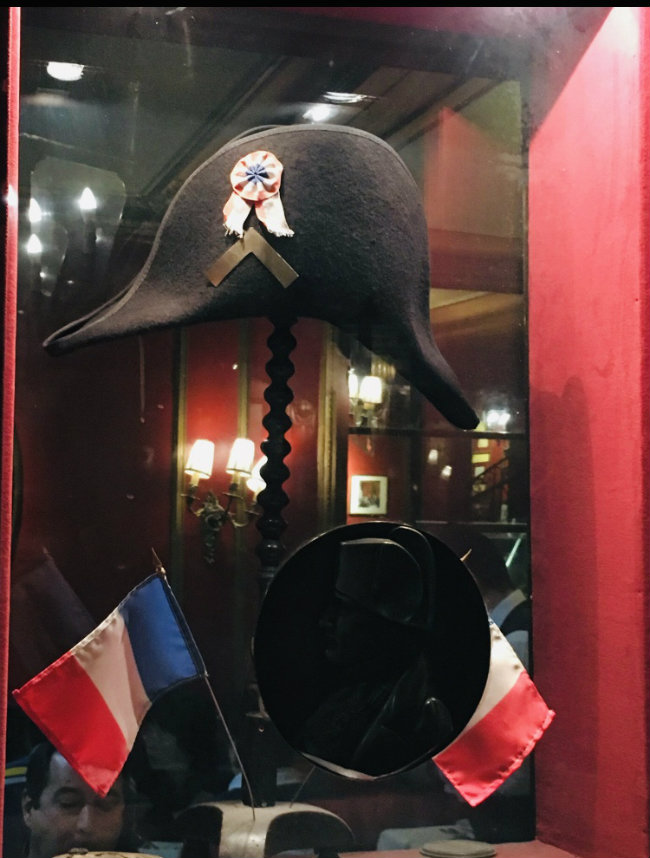
Napoleon’s hat on display at Le Procope. Photo: Claudine Hemingway
Just behind Le Procope, the short, uneven Cour du Commerce Saint-André connects the Boulevard Saint Germain to Rue Saint André des Arts. Although it is short, it holds many historical moments in the history of Paris. Joseph Guillotin would practice his machine on sheep in this street, Georges Danton lived here and Jean Paul Marat had his printing house here. If you walk down the Cour du Commerce, facing south just before you reach La Procope look up. Outside a window, you will see a bell. This bell dates back to the time when Marat would be working late into the night and would ring a bell when his article was printed and ready to be distributed.

Marat’s bell. Photo: Claudine Hemingway
Just off the Seine and in view of the Musée du Louvre is the school where many of its artists began: the École des Beaux-Arts. It dates back to 1648 when Cardinal Mazarin set up the school to educate the cream of the crop of French students in painting, sculpture and architecture. Louis XIV used the school to hand pick talent to decorate his ever-growing Versailles. Degas, Ingres, Moreau, Renoir, Géricault, Sissley and Delacroix all attended the prestigious school. It is still an active school today and holds many special exhibitions. To fully visit the Beaux-Arts you have to wait until the Journées Européennes du Patrimoine, the third weekend of September when many French institutes open for just one weekend to visitors. However, you can just stroll right in any day of the week to view a portion of this historic school. Inside you can view a copy of Michelangelo’s Pietà without jetting over to Rome. Copies of famous tombs seen at the Basilique Saint-Denis and the Cour du Mûrier that is filled with statues within the courtyard colonnade. Walk around (where you can) and you will come across sketching students, surrounded by columns from the former Palais des Tuileries in the Cour Chimay, looking out at the Linden trees gently blowing in the summer wind. An open door in Paris is always an invitation to explore.
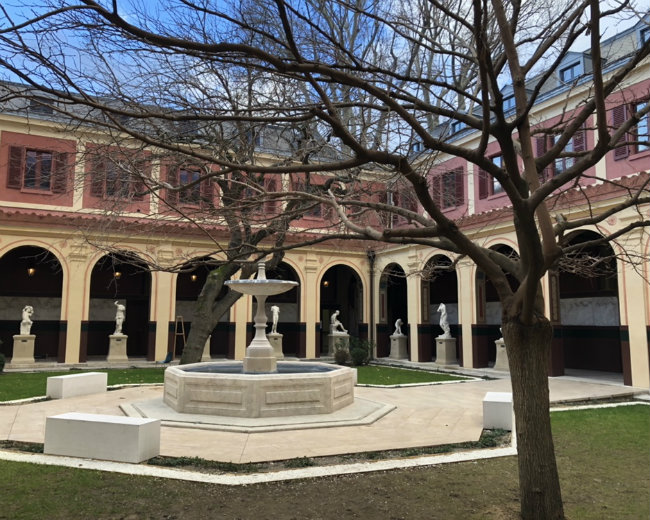
École des Beaux-Arts. Photo: Claudine Hemingway
When my grandparents traveled to Paris, my grandfather always had his trusty Konica camera with him on his early morning walks why my grandmother still slept. The empty streets before the city would wake up where the perfect hunting ground to capture on film. When I am in Paris, I always have some of those photos he took with me, as I do the same thing he did so many years ago. One photo in particular stands out over many. Along the Boulevard Saint Germain, there’s a building with a very distinct façade. The carved stone of the former Ministry of War, upon closer inspection is filled with bullet holes. Remains of the days World War I came to Paris are still visible and a reminder of what happened. On March 11 1918, as Paris came under fire, the building was hit with gunfire. I love that these are left as a reminder of history and what Paris survived through and even more that my grandfather and I share the same passion.
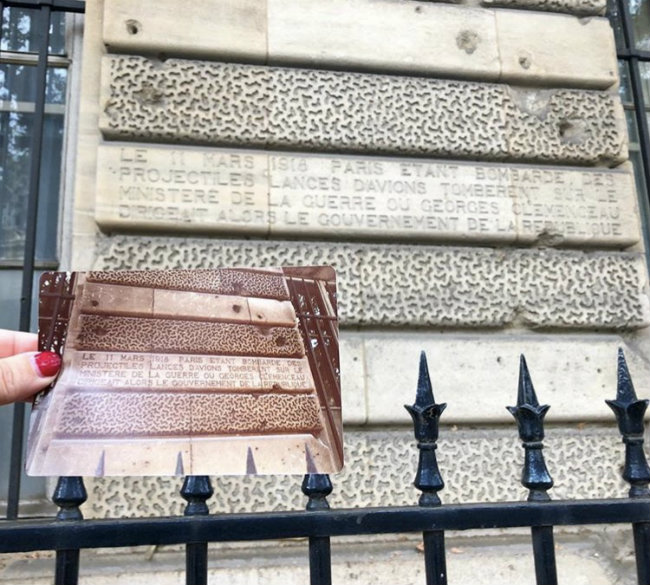
Ministry of War wall. Photo: Claudine Hemingway
Over the years in Paris, there were many men named Louis that ruled over France and left their mark. Louis IX, Saint Louis brought the relics of Christ to France, Louis XIV covered everything in gold and Louis XVI, well, he married an Austrian Princesses and then lost his head. However, a lesser known Louis XII who ruled at the start of the 16th century left behind a porcupine. Many of the kings hand an emblem that they emblazoned on their chateaus, walls and ceilings. François I liked the salamander and Henri II the crescent moon. Above a random door near Les Invalides at 82 Boulevard de la Tour-Maubourg is the porcupine of Louis XII topped with a crown. A keen eye will also spot it on a canon held inside the Musée de l’Armee just across the street.

The porcupine of Louis XII. Photo: Claudine Hemingway
She can be seen from all over Paris, the Eiffel Tower and her grand iron was only meant to last a few years. Luckily, she still remains and from her all of Paris is laid out in front of you. While you are searching for the monuments that dot the landscape look down a little closer and at the iron ladies feet. On the western side, nestled in the greenery is a rather uncommon sight and you may ask yourself why it is there. Near the Allée des Refuzniks the red brick turret dates back to 1887 when the Eiffel Tower was first built. Located over the former machine room, it was a ventilation tower for the gases and air coming off the machinery. It is unknown why this was left, after all the other structures built during the construction of the tower were removed. Easier to spot in the late fall and winter when the leaves have fallen, but a fun fact to point out when taking all of Paris in from the Eiffel Tower.
Paris is a never-ending treasure chest of things to discover. Each cobblestone, plaque and building has a story to tell. You can spend a lifetime lifting each layer breaking open the secrets she holds. Don’t miss my other two treasures of Paris in plain sight articles. Happy hunting!
Lead photo credit : Les Deux Magots, photo by Robyn Lee/ Public domain
More in hidden treasures
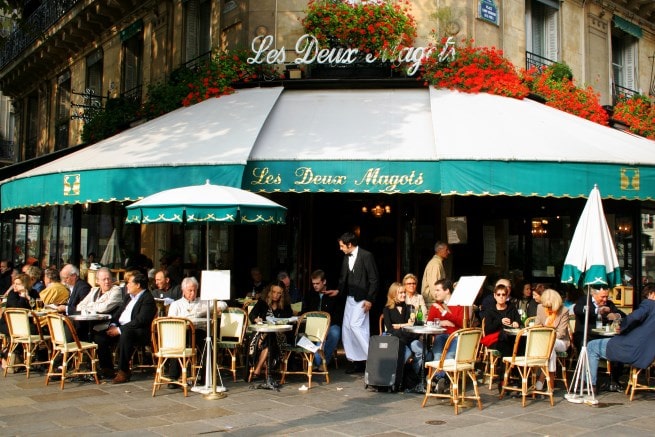





REPLY
REPLY
REPLY
REPLY